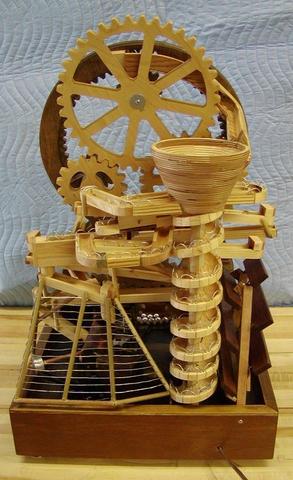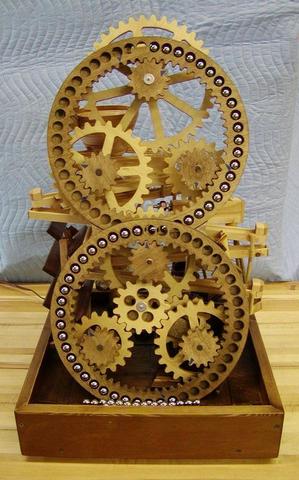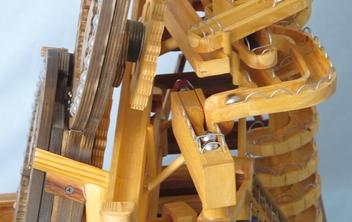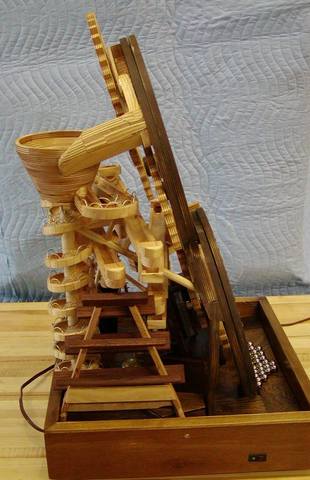 There are 16 gears hand-cut from 1/2" Baltic Birch plywood driven by an electric
gear reduction motor.
There are 16 gears hand-cut from 1/2" Baltic Birch plywood driven by an electric
gear reduction motor.


Marble Machine (definition: A Do-Nothing or Rube Goldberg Type Machine)
This is intended to be an awkward, overly complicated mechanism for the sole purpose of entertainment and to make noise in the process. People seem to enjoy watching gears turn and marbles running around in circles making noise.
 There are 16 gears hand-cut from 1/2" Baltic Birch plywood driven by an electric
gear reduction motor.
There are 16 gears hand-cut from 1/2" Baltic Birch plywood driven by an electric
gear reduction motor.
I started off with glass marbles and then switched to 5/8" ball bearings (which are 3 1/2 - 4 times heavier than glass marbles) because they are perfectly round. With the today's glass marbles each color is a slightly different size and they aren't even close to being perfectly round. Also, the glass marbles were chipping from all the crashing into each other. The ball bearings make much more noise.
The bearings run in all different directions. First they drop into a vortex funnel (or flower pot), which spins them and sends them on one of two possible tangential paths or down a spiral track. The paths from the vortex funnel lead to the zigzag tracks or a flip-flop mechanism. The bearings exit the vortex at high speed unless they don't hit the exit hole squarely, then they have a delayed exit, until the next one comes along and crashes into it or until it finds the center hole.
Distribution by the vortex funnel is random. Roughly 50% go to the left (down the zigzag tracks), 40% go to the right (where they make a sharp 180 turn to the flip-flop mechanism) and less than 10% go down the spiral. I'm actually only using ½ of the bearings. The other half is returned to the bottom down the zig-zag to get rid of them. I didn't have enough room for any more mechanisms.
 The flip-flop is a 50/50 split mechanism (half go right and half go left - works
like an A-B Switch). The flip-flop determines if the marbles go to the xylophone
or to a divide-by-3. The flip-flop works well. Sometimes it gets a slug of 3 or
4 bearings in a row and it rarely misses a beat.
The flip-flop is a 50/50 split mechanism (half go right and half go left - works
like an A-B Switch). The flip-flop determines if the marbles go to the xylophone
or to a divide-by-3. The flip-flop works well. Sometimes it gets a slug of 3 or
4 bearings in a row and it rarely misses a beat.
The divide-by-3 mechanism is a counting, weighing or delaying device. In this
case it does all three. From the divide-by-3 they drop into a dump-o-matic
which holds 12 marbles before it dumps (making it a divide-by-12 mechanism)
and it makes a bunch of noise. Marbles run down the spiral track and ring a
couple of old brass A-B tone telephone bells at the bottom. Marbles from the
dump-o-matic also ring the telephone bells. When the marbles get back to the
base, they all rush to the front to take another ride in the elevating ring gears.

Xylophone at the bottom left of the machine |
The xylophone bars are made from rosewood.
The ring gears are held in position by gravity.
The bearings move fast and have a lot of momentum. The bearings would frequently hit the end stop at the end of a zig-zag track and climb right over the end (resulting in escapees) before having a chance to fall through the hole. The vortex funnel puts spin on the bearings resulting in the bearings running up and over the curves or spiral. Thus the reason for the zig-zag track end caps and guardrails on the curves and spiral. I had bearings and marbles from one end of my shop to the other. They know how to scatter, they are fast on a concrete floor, and they find unbelievable hiding places!
The reason for the baseball style backstop is to stop bounce-out escapees. Sometimes the divide-by-3 only divides by 1 or 2 and/or the dump-o-matic may only contain 10 or 11. When 3 more dump into the dump-o-matic, the marbles spill over, bounce around and can escape the machine.
The Marble Machine weights 30 pounds, stands 30 inches high, the base is 19" square and the ring gears are 14-1/2" diameter. It moves over 7000 bearings per hour and holds with 75 bearings.